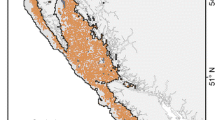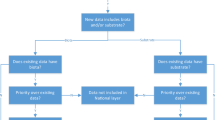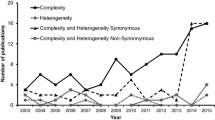Abstract
Creating a habitat classification and mapping system for marine and coastal ecosystems is a daunting challenge due to the complex array of habitats that shift on various spatial and temporal scales. To meet this challenge, several countries have, or are developing, national classification systems and mapping protocols for marine habitats. To be effectively applied by scientists and managers it is essential that classification systems be comprehensive and incorporate pertinent physical, geological, biological, and anthropogenic habitat characteristics. Current systems tend to provide over-simplified conceptual structures that do not capture biological habitat complexity, marginalize anthropogenic features, and remain largely untested at finer scales. We propose a multi-scale hierarchical framework with a particular focus on finer scale habitat classification levels and conceptual schematics to guide habitat studies and management decisions. A case study using published data is included to compare the proposed framework with existing schemes. The example demonstrates how the proposed framework’s inclusion of user-defined variables, a combined top-down and bottom-up approach, and multi-scale hierarchical organization can facilitate examination of marine habitats and inform management decisions.









Similar content being viewed by others
References
Altieri AH, Witman JD (2006) Local extinction of a foundation species in a hypoxic estuary: integrating individuals to ecosystem. Ecology 87:717–730
Anderson JT, Van Holliday D, Kloser R, Reid DG, Simard Y (2008) Acoustic seabed classification: current practice and future directions. ICES Journal of Marine Science 65:1004–1011
Boothroyd JS, August PV (2008) Geologic and contemporary landscapes of the Narragansett Bay Ecosystem. In: Desbonnet A, Costa-Pierce BA (eds) Science for ecosystem-based management: Narragansett Bay in the 21st Century. Springer, New York, pp 1–34
Brown C, Collier J (2008) Mapping benthic habitat in regions of gradational substrata: An automated approach utilising geophysical, geological, and biological relationships. Estuarine, Coastal, and Shelf Science 78:203–214
Clarke A (2008) Antarctic marine benthic diversity: patterns and processes. Journal of Experimental Marine Biology and Ecology 366:48–55
Connor DW, Allen JH, Golding N, Howell K, Lieberknecht LM, Northen KO, Reker JB (2004) The marine habitat classification for Britain and Ireland, version 04.05. Joint Nature Conservation Committee (JNCC), UK. www.jncc.gov.uk/page-1645, February 2008
Cortner HJ, Moote MA (1999) A Paradigm Shift. In: The politics of ecosystem management. Island Press, Washington, DC, pp 37–54
Council on Environmental Quality (CEQ) (2009) Interim Report of The Interagency Ocean Policy Task Force. The White House, Washington, DC, p 38
Cummings V, Thrush S, Norkko A, Andrerw N, Hewitt J, Funnell G, Schwarz A (2006) Accounting for local scale variability in benthos: implications for future assessment of latitudinal trends in the coastal Ross Sea. Antarctic Science 18:633–644
Deither MN, Schoch GC (2005) The consequences of scale: assessing the distribution of benthic populations in a complex estuarine fjord. Estuarine, Coastal and Shelf Science 62:253–270
Diaz RJ, Solan M, Valente RM (2004) A review of approaches for classifying benthic habitats and evaluating habitat quality. Journal of Environmental Management 73:165–181
Duarte CM, Dennison WC, Orth RJW, Carruthers TJB (2008) The charisma of coastal ecosystems: addressing the imbalance. Estuaries and Coasts 31:233–238
Eastwood P, Souissi S, Rogers S, Coggan R, Brown C (2006) Mapping seabed assemblages using comparative top-down and bottom-up classification approaches. Canadian Journal of Fisheries and Aquatic Science 63:1536–1548
European Environment Agency (EEA) (2004) European Nature Information System (EUNIS). http://eunis.eea.eu.int/habitats.jsp (December 2007)
Fraschetti S, Terlizzi A, Boero F (2008) How many habitats are there in the sea (and where)? Journal of Experimental Marine Biology and Ecology 366:109–115
Frederiksen M, Krause-Jensen D, Holmer M, Laursen J (2004) Long-term changes in area distribution of eelgrass (Zostera marina) in Danish coastal waters. Aquatic Botany 78:167–181
Gerber LR, Morissette L, Kaschner K, Pauly D (2009) Should Whales be culled to increase fishery yield? Science 323:880–881
Greene HG, Bizzarro JJ, O’Connell VM, Brylinsky CK (2007) Construction of digital potential marine benthic habitat maps using a coded classification system and its application. Geological Association of Canada Special Paper 47:147–161
Guarinello ML (2009) Habitats in a coastal lagoon experiencing episodic hypoxia. MS Thesis. University of Rhode Island Graduate School of Oceanography, Narragansett, RI, p 240
Guest J (2008) How reefs respond to mass coral spawning. Science 320:621–623
Gunderson LH (2000) Ecological resilience- in theory and application. Annual Review of Ecology and Systematics 31:425–439
Hall SJ, Raffaelli D, Thrush SF (1992) Patchiness and disturbance in shallow water benthic assemblages. In: Giller PS, Hildrew AG, Raffaelli DG (eds) Aquatic ecology: scale, pattern, and process. Blackwell Scientific Publications, Oxford, pp 333–374
Halpern BS, Walbridge S, Selkow KA, Kappel CV, Micheli F, D’Agrosa C, Bruno JF, Casey KS, Ebert C, Fox HE, Fujita R, Heinemann D, Lenihan FS, Madin EMP, Perry MT, Selig ER, Spalding M, Steneck R, Watson R (2008) A global map of human impact on marine ecosystems. Science 319:948–952
Hewitt JE, Thursh SF, Cummings VJ, Turner SJ (1998) The effect of changing sampling scales on our ability to detect effects of large-scale processes on communities. Journal of Experimental Marine Biology and Ecology 227:251–264
Hewitt JE, Thrush SF, Legendre P, Funnell GA, Ellis J, Morrison M (2004) Mapping of marine soft-sediment communities: integrated sampling for ecological interpretation. Ecological Applications 14:1203–1216
Hinchey EK, Nicolson MC, Zajac RN, Irlandi EA (2008) Preface: marine and coastal applications in landscape ecology. Landscape Ecology 23:1–5
Holmes KW, Van Niel K, Baxter K, Kendrick G (2004) Designs for marine remote sampling: a review and discussion of sampling methods, layout, and scaling issues. CRC for Coastal Zone Estuary and Waterway Management Project CB3: Benthic Biology and Habitat Mapping Task 2.1 Milestone Report, May 2004 37
Hume T, Snelder T, Weatherhead M, Liefting R (2007) A controlling factor approach to estuary classification. Ocean and Coastal Management 50:905–929
Kay J, Schneider ED (1994) Embracing complexity, the challenges of the ecosystem approach. Alternatives 20:32–38
Keefer ML, Perry CA, Wright N, Daigle WR, Caudill CC, Clabough TS, Griffith DW, Zacharias MA (2008) Evaluating the NOAA Coastal and Marine Ecological Classification Standard in estuarine systems: A Columbia River Estuary case study. Estuarine, Coastal, and Shelf Science 78:89–106
Levin SA (1992) The problem of pattern and scale in ecology: the Robert H. MacArthur award lecture. Ecology 73:1943–1967
Lund K, Wilbur AR (2007) Habitat classification feasibility study for coastal and marine environments in Massachusetts. Massachusetts Office of Coastal Zone Management, Boston, p 58
Madden CJ, Grossman DJ, Goodin KL (2005) Coastal and Marine Systems of North America: framework for an ecological classification standard: version II. NatureServe, Arlington, p 48
Madden CJ, Goodin KL, Allee RJ, Finkbeiner M, Bamford D (2008) Coastal and Marine Ecological Classification Standard. NOAA and NatureServe, Silver Spring, Arlington, p 77
Madden CJ, Goodin KL, Allee RJ, Cicchetti G, Moses C, Finkbeiner M, Bamford D (2009) Coastal and Marine Ecological Classification Standard. NOAA and NatureServe, Silver Spring, Arlington, p 107
McGarigal K, Cushman SA (2005) The gradient concept of landscape structure. In: Wiens JA, Moss MR (eds) Issues and perspectives in landscape ecology. Cambridge University Press, Cambridge, pp 112–119
McGonigle C, Brown C, Quinn R, Grabowski J (2009) Evaluation of image-based multibeam sonar backscatter classification for benthic habitat discrimination and mapping at Stanton Banks, UK. Estuarine, Coastal and Shelf Science 8:423–437
McMaster RL (1960) Sediments of the Narragansett Bay system and Rhode Island. Journal of Sedimentary Petrology 30:249–274
Melrose DC, Oviatt CA, Berman MS (2007) Hypoxic events in Narragansett Bay, Rhode Island, during the summer of 2001. Estuaries and Coasts 40:46–53
New Zealand Ministry of the Environment (2005) New Zealand marine environment classification. Wellington, New Zealand, p 80
Oakley BA, Boothroyd JC (2006) Benthic geologic habitats of Greenwich Bay, Rhode Island. Abstracts with Programs. Geological Society of America, Philadelphia, p 11
Palumbi SR, Sandifer PA, Allan JD, Beck MW, Fautin DG, Fogarty MJ, Halpern BS, Incze LS, Leong J, Norse E, Stachowicz JJ, Wall DH (2009) Managing for ocean biodiversity to sustain marine ecosystem services. Frontiers in Ecology and the Environment 7(4):204–211
Rabeni CF, Doisy KE, Galat DL (2002) Testing the biological basis of a stream habitat classification using benthic invertebrates. Ecological Applications 12:782–796
Raffaelli D, Bell E, Weithoff G, Matsumoto A, Cruz-Motta JJ, Kershaw P, Parker R, Parry D, Jones M (2003) The ups and downs of benthic ecology: considerations of scale, heterogeneity and surveillance for benthic-pelagic coupling. Journal of Experimental Marine Biology and Ecology 285–286:191–203
Slocombe DS (1998) Defining goals and criteria for ecosystem-based management. Environmental Management 22:483–493
Stevens T, Connolly RW (2004) Testing the utility of abiotic surrogates for marine habitat mapping at scales relevant to management. Biological Conservation 119:351–362
Thrush SF, Schneider DC, Legendre P, Whitlach RB, Dayton PK, Hewitt JE, Hines AH, Cummings VJ, Lawrie SM, Grant J, Pridmore RD, Turner SJ, McArdle BH (1997) Scaling-up from experiments to complex ecological systems: Where to next? Journal of Experimental Marine Biology and Ecology 216:243–254
United States Ocean Action Plan (2004) Office of the President of the United States. http://ocean.ceq.gov/actionplan.pdf. LMEs available at http://www.lme.noaa.gov/Portal/
Valentine PC, Todd BJ, Kostylev VE (2005) Classification of marine sublittoral habitats, with application to the northeastern North America region. American Fisheries Society Symposium 41:183–200
Valles H, Kramer DL, Hunte W (2008) Temporal and spatial patterns in the recruitment of coral reef fishes in Barbados. Marine Ecology Progress Series 363:257–272
Van Lancker V, Foster-Smith R (2007) How do I make a map? In: MESH Guide to Habitat Mapping, MESH Project, 2007. Joint Nature Conservation Committee (JNCC), Peterborough, p 77
Wiens JA (1989) Spatial scaling in ecology. Functional Ecology 3:385–397
Wu J (1999) Hierarchy and scaling: extrapolating information along a scaling ladder. Canadian Journal of Remote Sensing 25:367–380
Wu J, David JL (2002) A spatially explicit hierarchical approach to modeling complex ecological systems: theory and applications. Ecological Modeling 153:7–26
Yaffee SL (1999) Three faces of ecosystem management. Conservation Biology 13:713–725
Zajac RN (1999) Understanding the seafloor landscape in relation to impact assessment and environmental management in coastal marine sediments. In: Gray JS, Ambrose W Jr, Szaniawska A (eds) Biogeochemical cycling and sediment ecology. Kluwer, Dordrecht, pp 211–227
Zajac RN (2008) Challenges in marine, soft-sediment benthoscape ecology. Landscape Ecology 23:7–18
Zajac RN, Whitlach RB, Thrush SF (1998) Recolonization and succession in soft-sediment infaunal communities: the spatial scale of controlling factors. Hydrobiologia 375(376):227–240
Zajac RN, Lewis RS, Poppe LJ, Twichell DC, Vozariak J, DiGiacomo-Cohen ML (2000) Relationships among sea-floor structure and benthic communities in Long Island Sound at regional and benthoscape scales. Journal of Coastal Research 16:627–640
Acknowledgments
Early thoughts concerning management issues were sparked by readings and discussion in a URI Marine Affairs class taught by Richard Burroughs. Charley Roman (National Park Service) and two anonymous reviewers provided thoughtful comments on an early draft. The Weekapaug Foundation for Conservation, the O.W. Caspersen Foundation, the Shelter Harbor Conservation Foundation, the RI SeaGrant BayMap project, NSF IGERT Grant # 0504103, and the RI MapCoast Partnership provided funding for this project.
Author information
Authors and Affiliations
Corresponding author
Rights and permissions
About this article
Cite this article
Guarinello, M.L., Shumchenia, E.J. & King, J.W. Marine Habitat Classification for Ecosystem-Based Management: A Proposed Hierarchical Framework. Environmental Management 45, 793–806 (2010). https://doi.org/10.1007/s00267-010-9430-5
Received:
Accepted:
Published:
Issue Date:
DOI: https://doi.org/10.1007/s00267-010-9430-5




